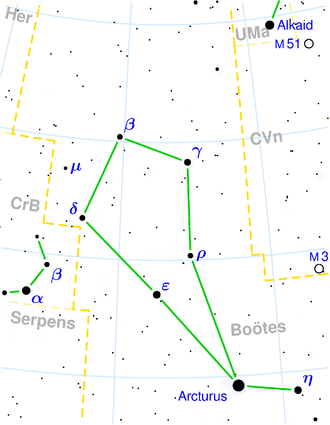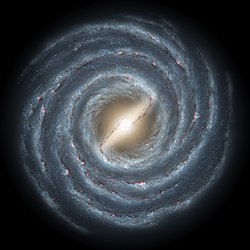Bootes-III-Zwerggalaxie
| Galaxie Bootes-III-Zwerggalaxie | |
|---|---|
| AladinLite | |
| Sternbild | Bärenhüter |
| Position Äquinoktium: J2000.0, Epoche: J2000.0 | |
| Rektaszension | 13h 57m 00s[1] |
| Deklination | 26° 48′ 00″ [1] |
| Erscheinungsbild | |
| Morphologischer Typ | dSph/dIrr [2] |
| Helligkeit (visuell) | 12,6 mag [2][3] |
| Winkelausdehnung | 1,5' × 0,8' [2] |
| Flächenhelligkeit | (31,3 ± 0,3) mag/arcmin² [4] |
| Physikalische Daten | |
| Zugehörigkeit | Lokale Gruppe |
| Entfernung | 150.000 Lj / 46.000 pc [2] |
| Absolute Helligkeit | (−5,8 ± 0,5) mag [4] |
| Metallizität [Fe/H] | −2,1 ± 0,2 |
| Geschichte | |
| Entdeckungsdatum | 2009 |
| Katalogbezeichnungen | |
| Boo III[2] | |
Die Bootes-III-Zwerggalaxie (kurz auch Bootes III) ist eine sich im Zerfall befindende Zwerggalaxie im Sternbild des Bärenfängers und noch als Überhäufigkeit im galaktischen Halo zu erkennen. Sie wurde im Jahr 2009 in Aufnahmen der Durchmusterung des Sloan Digital Sky Survey entdeckt[2].
Eigenschaften
Größen
Die Galaxie befindet sich in einer Entfernung von 46 kpc zu unserem Sonnensystem und bewegt sich auf unsere Sonne mit einer Geschwindigkeit von 200 km/s zu.[2][3] Sie besitzt eine ellipsoide Form mit einem Achsverhältnisse von etwa 2:1 und einem Halblichtradius von 400 pc[4]. Die große Ausdehnung einerseits und die irreguläre Form anderseits zeigen, dass sich Bootes III im Übergang befindet von einem gravitativ gebunden zu einem gravitativ ungebundenem System.[2]
Die Masse von Bootes III lässt sich eben aufgrund dieser Tatsache nur äußerst schwer abschätzen, da in diesem Fall die Geschwindigkeitsdispersion nicht mit der Masse der Galaxie korreliert[3]. Bootes III ist möglicherweise auch die Quelle des Styx-Stroms im galaktischen Halo, der zeitgleich mit der Galaxie entdeckt wurde.[2]
Leuchtkraft
Bootes III ist eine der lichtschwächsten Trabanten unserer Milchstraße, die integrale Leuchtkraft ist lediglich das 18.000-fache derjenige der Sonne mit MV = −5,8m, was geringer ausfällt als die Leuchtkraft der meisten Kugelsternhaufen.[4]
Metallizität
Die Sternpopulation von Bootes III beinhaltet hauptsächlich ältere Sterne, die vor etwa 12 Milliarden Jahren entstanden sind.[4] Die Metallizität dieser alten Sterne ist entsprechend gering mit [Fe/H] = −2,1 ± 0,2, d. h. Bootes III besitzt ein 120stel an schweren Elementen, verglichen mit unserer Sonne.[3]
Weiteres
Weblinks
Einzelnachweise
- ↑ SIMBAD Astronomical Database. In: Results for Bootes III. Abgerufen am 13. Februar 2010.
- ↑ a b c d e f g h i C. J. Grillmair: Four New Stellar Debris Streams in the Galactic Halo. In: The Astrophysical Journal. Band 693, Nr. 2, 2009, S. 1118–1127, doi:10.1088/0004-637X/693/2/1118, arxiv:0811.3965, bibcode:2009ApJ...693.1118G.
- ↑ a b c d Jeffrey L. Carlin, Carl J. Grillmair, Ricardo R. Muñoz u. a.: Kinematics and Metallicities in the Boötes III Stellar Overdensity: a Disrupted Dwarf Galaxy? In: The Astrophysical Journal Letters. Band 702, Nr. 1, 2009, S. L9–L13, doi:10.1088/0004-637X/702/1/L9, arxiv:0907.3738, bibcode:2009ApJ...702L...9C.
- ↑ a b c d e M. Correnti, M. Bellazzini, F. R. Ferraro: Red Clump stars in the Bootes III stellar system. In: Mon. Not. R. Astron. Soc. Band 397, Nr. 1, 2009, S. L26–L30, doi:10.1111/j.1745-3933.2009.00677.x, arxiv:0904.3068, bibcode:2009MNRAS.397L..26C.
Auf dieser Seite verwendete Medien
Caption from NASA: Like early explorers mapping the continents of our globe, astronomers are busy charting the spiral structure of our galaxy, the Milky Way. Using infrared images from NASA's Spitzer Space Telescope, scientists have discovered that the Milky Way's elegant spiral structure is dominated by just two arms wrapping off the ends of a central bar of stars. Previously, our galaxy was thought to possess four major arms.
This artist's concept illustrates the new view of the Milky Way, along with other findings presented at the 212th American Astronomical Society meeting in St. Louis, Mo. The galaxy's two major arms (Scutum-Centaurus and Perseus) can be seen attached to the ends of a thick central bar, while the two now-demoted minor arms (Norma and Sagittarius) are less distinct and located between the major arms. The major arms consist of the highest densities of both young and old stars; the minor arms are primarily filled with gas and pockets of star-forming activity.
The artist's concept also includes a new spiral arm, called the "Far-3 kiloparsec arm," discovered via a radio-telescope survey of gas in the Milky Way. This arm is shorter than the two major arms and lies along the bar of the galaxy.
Our sun lies near a small, partial arm called the Orion Arm, or Orion Spur, located between the Sagittarius and Perseus arms.



